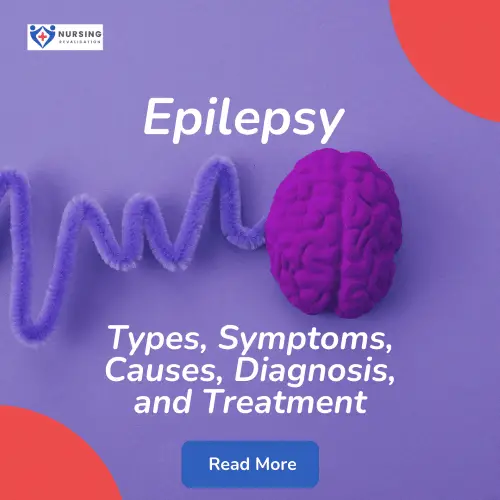Recurrent seizures are common in people who have epilepsy. These seizures are caused by a breakdown in brain electrical activity, which disrupts the message systems between brain cells for a short period. In this blog, you will get a brief introduction to epilepsy, its types, causes, symptoms, diagnosis, and treatment.
What is Epilepsy?
Epilepsy is a neurological disorder that produces recurring, spontaneous seizures. A seizure is a burst of aberrant electrical activity in your brain that occurs suddenly. When you experience two or more seizures without a known cause, your doctor will diagnose you with epilepsy.
Types of epilepsy seizure
Doctors can often figure out the causes of seizures.
There are two types of seizures, depending on whether the cause can be identified:
- Idiopathic, or cryptogenic: There is no obvious reason, or the doctor is unable to determine the cause.
- Symptomatic: The clinician is aware of the underlying reason.
There are three types of seizures depending on where the seizure starts in the brain.:
- Partial
- Generalized
- Secondary generalized
During a seizure, a person’s experience will be determined by the damaged brain area and how widely and quickly the electrical activity in the brain spreads from there.
Partial seizure
When epileptic activity happens in only one portion of a person’s brain, it is called a partial seizure. A partial seizure can be divided into two types:
- Simple partial seizure: The person is cognizant during this type of seizure. Even when the seizure is in progress, people are usually aware of their surroundings.
- Complex partial seizure: This form of seizure causes a person’s consciousness to be impaired. They are unlikely to recall the seizure. If they do, they will have a hazy remembrance of it.
Generalized seizure
When epileptic activity affects both halves of the brain, it is called a generalized seizure. While the seizure is happening, the victim frequently loses consciousness.
 Subtypes of Generalized seizure
Subtypes of Generalized seizure
A generalized seizure can be divided into numerous subtypes, including:
- Tonic-clonic seizures:
Tonic-clonic seizures produce loss of consciousness, rigidity, and shaking, and are perhaps the most well-known type of generalized seizure. These seizures were traditionally referred to as grand mal seizures by doctors.
- Absence seizures:
It is also known as petit mal seizures; absence seizures are characterized by brief lapses of awareness during which the person appears to be staring out into space. Treatment for absence seizures is usually effective.
- Tonic seizures:
When a person has a tonic seizure, their muscles stiffen, and they may fall.
- Atonic seizures:
The person drops suddenly due to a loss of muscular tone.
- Clonic seizures:
This form of seizure generates jerky, rhythmic movements, usually in one arm or leg.
- Myoclonic seizures:
This type of seizure causes the upper torso or legs to jolt or twitch suddenly.
Secondary generalized seizure
When epileptic activity begins as a partial seizure but expands to both half of the brain, it is called a secondary generalized seizure. The person will lose consciousness as the seizure progresses.
What are the main causes of epilepsy?
In nearly half of those who suffer from epilepsy, there is no known cause. The condition in the other half can be attributed to several variables, including:
- Genetic factors: Some forms of epilepsy, which are classified according to the type of seizure, or the portion of the brain affected, run in families. There is most certainly a hereditary component in these situations. Some types of epilepsy have been related to specific genes, although genes are only one element of the epileptic puzzle for most people. Certain genes may make a person more susceptible to seizure-inducing environmental factors.
- Head Trauma: Epilepsy can be caused by head trauma from a vehicle accident or another traumatic injury.
- Brain abnormalities: Epilepsy can be caused by brain abnormalities such as brain tumors or vascular malformations such as arteriovenous malformations (AVMs) and cavernous malformations. Stroke is the most common cause of epilepsy in people over the age of 35.
- Infections: Epilepsy can be caused by meningitis, HIV, viral encephalitis, and various parasite illnesses.
- Prenatal injury: Babies are vulnerable to brain injury before birth, which can be caused by a variety of circumstances such as the mother’s infection, poor nutrition, or oxygen deficiency. Epilepsy or cerebral palsy can be caused by brain injury.
- Developmental disorders: Epilepsy and developmental disorders like autism are sometimes associated with each other.
What are the warning signs of Epilepsy?
 Seizures can disrupt any process that your brain coordinates. The most common symptoms of epilepsy are following:
Seizures can disrupt any process that your brain coordinates. The most common symptoms of epilepsy are following:
- Temporary confusion
- A staring spell
- Uncontrollable jerking motions of the arms and legs are some of the indications and symptoms of a seizure
- Stiff muscles
- Psychological symptoms such as fear, or worry
The severity of the symptoms varies based on the type of seizure. A person with epilepsy, in most situations, experience the same sort of seizure every time, therefore the symptoms will be consistent from episode to episode.
How to diagnose epilepsy seizures?
If you think you’ve had a seizure, go to the doctor right away. A seizure can be a sign of a more serious medical condition.
 Your doctor will use your medical history and symptoms to determine which tests are necessary. They’ll most likely do a neurological examination to assess your motor skills and mental ability.
Your doctor will use your medical history and symptoms to determine which tests are necessary. They’ll most likely do a neurological examination to assess your motor skills and mental ability.
Other illnesses that produce seizures should be cleared out before diagnosing epilepsy. A complete blood count (CBC) and blood chemistry will almost certainly be ordered by your doctor.
Blood tests may be used to look for:
- signs of infectious diseases
- liver and kidney function
- blood glucose levels
These tests might include:
- CT scan
- MRI
- positron emission tomography (PET)
- single-photon emission computerized tomography
Epilepsy is usually diagnosed if you have seizures, but there’s no apparent or reversible cause.
Treatment of epilepsy
 Most persons with epilepsy can reduce or eliminate their seizures with treatment. The treatment includes:
Most persons with epilepsy can reduce or eliminate their seizures with treatment. The treatment includes:
- Anti-epileptic drugs (AEDs)
- Surgery to remove a small section of the brain that is causing the seizures
- involves implanting a tiny electrical device inside the body to aid in seizure management.
- A type of diet (ketogenic diet) that can aid in seizure management
Being a healthcare professional, you should provide effective care to seizure patients. You should know about the documentation and expected behavioral changes. To learn all this, join an epilepsy awareness course on nursing revalidation and pacify your healthcare journey.

